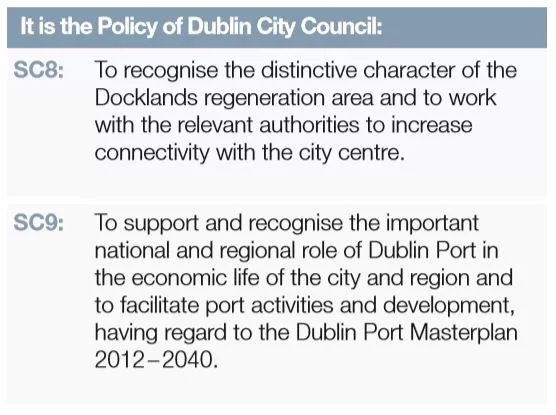4.5.1.2 Approach to the Docklands and the Port
4.5.1.2 Approach to the Docklands and the Port
The Docklands is often viewed as a new urban quarter, where the wider River Liffey and larger block structure, together with the juxtaposition of the Docklands to other waterbodies such Grand Canal Dock and the river Dodder, combine to create the potential for a completely new identity.
The challenge here is to ensure that the character of the Docklands is retained and is enhanced, and that good connectivity between the city centre and the Docklands is achieved such that the Docklands is seen as being an integral part of the city centre, rather than as a separate entity.
Significant achievements have been made in recent years, not only in the scale of commercial and apartment development, but also in creating a strong sense of place in this new urban quarter. The active use of the public realm in the Docklands to host events and the use of the waterbodies, such as the Grand Canal Dock, for active leisure or recreational uses significantly enhances the vitality of this evolving urban environment.
Other symbols of placemaking in the built environment include the 3 Arena (Point Depot), Mayor Square, the public spaces and square at Grand Canal Quay, and the campshires.
The North Lotts and Grand Canal strategic development zone (SDZ) includes strategies for the continued development of the Docklands, and builds on the earlier North Lotts planning scheme, the Grand Canal planning scheme, and the Dublin Docklands Masterplan 2008.
The provision of new Liffey bridges including the proposed bridge at the river Dodder will further improve connectivity of the Docklands with the city centre and the wider region. Dublin City Council fully supports and recognises the important national and regional role of Dublin Port in the economic life of the region and the consequent need in economic competitiveness and employment terms to facilitate port activities.
Dublin Port will have a significant role to play in the future development and growth of the city and it is considered prudent to plan the structure of this part of the city, including the proposed public transport network, to fully integrate with the developing new city structure and character, while having regard to the Dublin Port Company Masterplan 2012 – 2040.
New proposals by Dublin Port to accommodate cruise ships directly east of the Tom Clarke Bridge will further animate the campshires and general Docklands area, enhance the social and commercial environment of this urban quarter and will improve connectivity between the port and the city.
There is potential to include a marine services, hotel and exhibition centre in the Point area immediately east of the SDZ, to consolidate this cluster and complement the cruise shipping facility. Dublin City Council recognises Dublin Port as a major source of employment in the area as well as the need for a ferry terminal service and linkages to the natural amenities of Dublin Bay.
